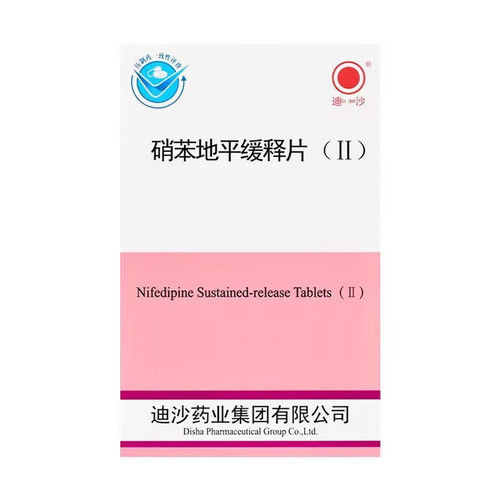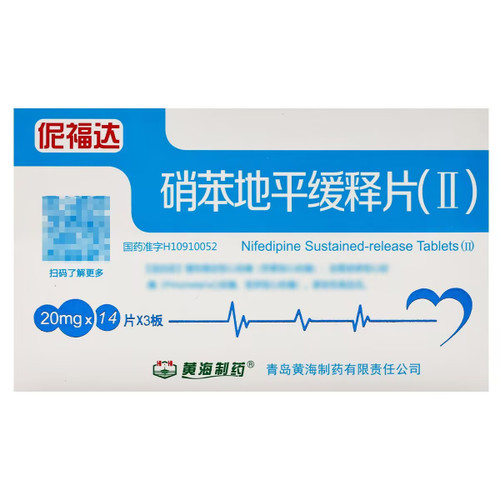Product Overview
[Drug name]
Generic name: Nifedipine sustained-release tablets (I)
Trade name: Kaida Nifedipine sustained-release tablets (I) 20mg*16 tablets
Pinyin full code: KaiDa XiaoBenDiPingHuanShiPian(I)20mg*16Pian
[Main ingredients]
The main ingredient and its chemical name of this product are: 2,6-dimethyl-4(2-nitrophenyl)-1,4-dihydro-3,5-pyridinedicarboxylic acid dimethyl ester.
[Properties]
This product is a sugar-coated tablet, which is yellow after removing the sugar coating. [Indications/Main Functions] Chronic stable angina (exertional angina); vasospastic angina (Prinzmetal’s angina, variant angina); essential hypertension. [Specifications] 20mg*16 tablets [Usage and Dosage] 1. The dose of nifedipine should be gradually adjusted according to the patient’s tolerance and control of angina. Overdose of nifedipine can cause hypotension. 2. Start with a small dose, generally starting at 10mg/time, 3 times a day orally; the commonly used maintenance dose is 10-20mg/time, 3 times a day orally. Some patients with obvious coronary spasm For patients with acute respiratory syndrome, up to 20-30 mg/time, 3-4 times a day can be used. The maximum dose should not exceed 120 mg/day. If the condition is urgent, 10 mg/time can be chewed or taken sublingually, and the dose can be repeated based on the patient's response to the drug. 3. It usually takes 7-14 days to adjust the dose. If the patient has obvious symptoms and the condition is urgent, the dose adjustment period can be shortened. Depending on the patient's response to the drug, the frequency of attacks and the dose of sublingual nitroglycerin, the dose of nifedipine can be adjusted from 10-20 mg to 30 mg/time, 3 times a day within 3 days. 4. For hospitalized patients under strict monitoring, the dose can be increased every 4-6 hours, and each dose can be increased every 1-2 hours, depending on the control of angina pectoris or ischemic arrhythmias. 10 mg per time.
[Adverse Reactions]
1. Common peripheral edema after taking the drug (peripheral edema is related to the dose, the incidence is 4% when taking 60 mg/day, and 12.5% when taking 120 mg/day); dizziness; headache; nausea; fatigue and facial flushing (10%). Transient hypotension (5%), most of which do not require discontinuation of the drug (transient hypotension is related to the dose, the incidence is 2% when the dose is <60 mg/day, and the incidence is 5% when taking 120 mg/day). Some patients have angina pectoris, which may be related to the hypotensive reaction. Palpitations; nasal congestion; chest tightness; shortness of breath; constipation; diarrhea; gastrointestinal cramps; abdominal distension; skeletal muscle inflammation; joint stiffness; muscle spasms; spermatorrhea 1. Nervousness; tremor; nervousness; sleep disorder; blurred vision; imbalance, etc. (2%). Syncope (0.5%), which will no longer occur if the dosage is reduced or used in combination with other anti-anginal drugs. 2. Rare anemia; leukopenia; thrombocytopenia; purpura; allergic hepatitis; gingival hyperplasia; depression; paranoia; instant blindness at peak blood drug concentration; erythromelalgia; antinuclear antibody positive arthritis, etc. (<0.5%). 3. Possible serious adverse reactions: Myocardial infarction and congestive heart failure incidence rate 4%; pulmonary edema incidence rate 2%; arrhythmia and conduction block incidence rate less than 0.5% each. 4. Allergic hepatitis, rash, and even exfoliative dermatitis may occur in people who are allergic to this product.
[Contraindications Taboo]
Pregnant women are prohibited from using it.
[Precautions]
1. Hypotension Most patients only have mild hypotension after taking nifedipine, and some patients have severe hypotension symptoms. This reaction often occurs during the dose adjustment period or when the dose is increased, especially when used in combination with beta-blockers. Blood pressure needs to be monitored during this period, especially when other antihypertensive drugs are used in combination. 2. Patients who undergo coronary artery bypass grafting (or other surgeries) under fentanyl anesthesia can suffer from severe hypotension when taking nifedipine alone or in combination with beta-blockers. If conditions permit, the drug should be discontinued for at least 36 days. 3. A very small number of patients with angina pectoris and/or myocardial infarction, especially those with severe coronary artery stenosis, experience reflex sympathetic excitement and increased heart rate after lowering blood pressure while taking nifedipine or increasing the dose, which increases the incidence of angina pectoris or myocardial infarction. 4. Peripheral edema 10% of patients experience mild to moderate peripheral edema, which is related to arterial dilation. Edema often occurs initially at the end of the lower limbs and can be treated with diuretics. For patients with congestive heart failure, it is necessary to distinguish whether the edema is caused by further deterioration of left ventricular function. 5. "Rebound" symptoms of β-blockers. Sudden discontinuation of β-blockers may cause edema. 6. Congestive heart failure A small number of patients who have been treated with beta-blockers may develop heart failure after starting to take nifedipine, and patients with severe aortic stenosis are at greater risk. 7. Interference with diagnosis When using this product, alkaline phosphatase, creatine phosphokinase, lactate dehydrogenase, aspartate aminotransferase and alanine aminotransferase may occasionally increase. Generally, there are no clinical symptoms, but there have been reports of cholestasis and jaundice; platelet aggregation is reduced and bleeding time is prolonged; direct Coo MB test positive with/without hemolytic anemia 8. Patients with impaired liver and kidney function and those taking beta-blockers should use this drug with caution. It is advisable to start with a small dose to prevent inducing or aggravating hypotension and increasing the incidence of angina pectoris, heart failure, and even myocardial infarction. Patients with chronic renal failure occasionally experience reversible increases in blood urea nitrogen and creatinine when using this drug, and the relationship with nifedipine is not clear. 9. Long-term administration should not be stopped suddenly to avoid the occurrence of withdrawal syndrome and rebound phenomenon.
[Medication for elderly patients]
The half-life of nifedipine is prolonged in the elderly, so pay attention to adjusting the dose when using it.






